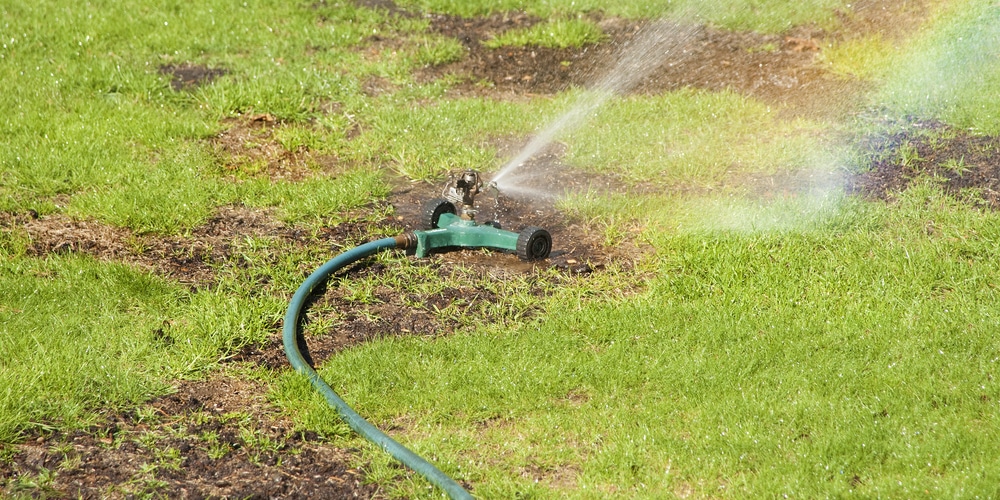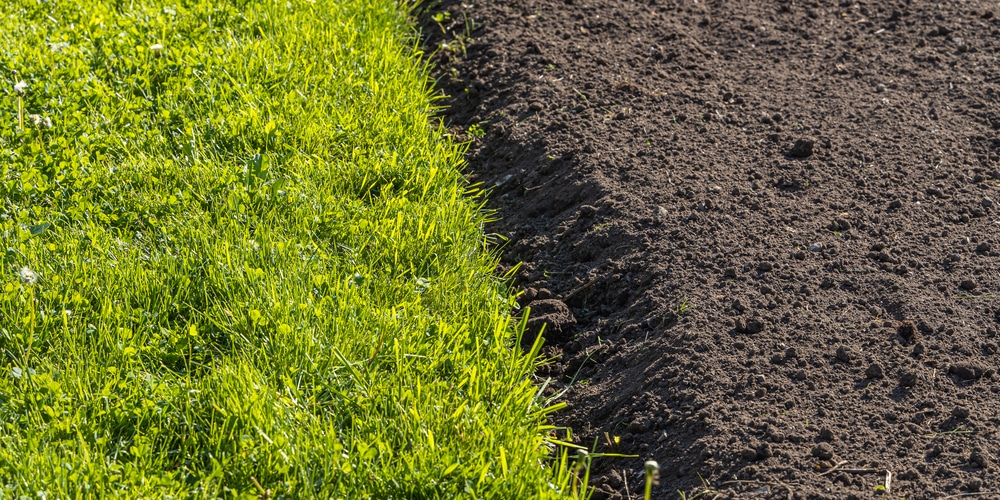Planting grass seed on hard dirt may seem challenging, but with the right approach, you can transform a barren plot into a lush, green lawn.
The condition of the soil is paramount when it comes to seeding, as compacted or hard ground can hinder seed germination and root growth.
To ensure success, the soil must be properly prepared to create an environment conducive for the new grass to thrive.
The process begins with loosening the soil and improving its structure, which allows for better water absorption and root penetration.
Amending the soil with organic material not only assists in breaking up hard dirt but also enriches it with nutrients essential for seedling development.
Water management is another crucial aspect – too little and the seeds may dry out, too much and they might rot. Achieving a balance will create the ideal conditions for your grass seeds to germinate and establish themselves.
Preparing the Soil
Successful grass seed germination begins with a well-prepared seedbed. Tailoring your soil to provide the best possible environment for grass seeds is crucial for a lush lawn.
Testing Soil Quality
To ensure a favorable setting for your grass seeds, test the soil’s moisture level by digging six inches down and forming a ball with the soil in your hand. It should crumble easily when squeezed.
If it’s too crumbly or too compact, you’ll need to adjust the water content before planting.
Loosening Hard Dirt
Once you’ve established that your soil moisture is balanced, the next step involves loosening the compacted soil.
Hard dirt impedes root growth and seed germination, so use a garden fork or tiller to break up the soil to a depth of about 2 to 3 inches.
This process enhances air and water circulation, facilitating a nurturing environment for new seeds.
Improving Soil Structure
Improving the soil structure encompasses integrating organic matter or quality topsoil to enrich the existing dirt.
Adding a thin layer of compost or well-aged manure can inject vital nutrients into the ground. Additionally, a balanced 10-10-10 fertilizer can lay the foundation for sustained growth.
For best results, evenly distribute the soil enhancements and rake them gently into the top layer of your seedbed.
How to Choose the Right Grass Seed
Selecting the proper grass seed is the foundation for establishing a resilient and thriving lawn. Identify grass species suited to your region’s climate and consider the light exposure of your planting area to ensure optimal growth.
Understanding Grass Varieties
Various grass seeds thrive in different conditions, and choosing the right one is pivotal for successful germination on hard dirt.
Cool-season grasses, like Kentucky bluegrass and fescue, excel in northern climates, while warm-season varieties such as Bermuda and Zoysia are better suited for southern areas.
Assess your lawn’s conditions—whether it faces intensive foot traffic or requires drought tolerance—to inform your choice.
Selecting Seeds for Shade Tolerance
If your lawn area is partially or fully shaded, selecting shade-tolerant grass varieties becomes essential.
Species like fine fescue or shade-tolerant St. Augustine grass can perform well in lower light conditions. Always check the seed packaging for shade tolerance indications to ensure your grass can thrive even with limited sunlight exposure.
Considering Climate and Season
Grass seeds vary not only in their seasonal growth patterns but also in their adaptability to different climates.
For colder regions, consider species with frost resistance, while in warmer climates, opt for heat-tolerant seeds.
Timing your planting to align with the onset of your region’s growing season—early fall for cool-season grasses and late spring for warm-season varieties—can significantly enhance germination rates and establishment success.
Planting the Grass Seed
Successful grass seed germination begins with proper soil preparation, but the actual planting is just as crucial for establishing a lush lawn. Master the timing, technique, and post-planting care to ensure your hard dirt transforms into a green oasis.
Timing for Seeding
Best Season: For optimal results, plant cool-season grass seed in the early fall and warm-season grass seed in late spring to early summer.
This timing allows your grass to establish itself during moderate temperatures and beneficial rainfall patterns.
- Cool-Season Grass: Early Fall
- Warm-Season Grass: Late Spring to Early Summer
Seeding Techniques
Preparation is Key: Before sowing, break up the soil to a depth of 3 to 6 inches and remove any debris.
- Broadcast Spreading: Evenly spreading seeds by hand or with a seed spreader to cover the entire area.
- Pro Tip: Use a crisscross pattern to avoid bare spots.
- Seed-to-Soil Contact: Once dispersed, lightly rake the area to ensure seeds make good contact with the soil, which is crucial for germination.
- Mulching: After seeding, cover the area with a thin layer of mulch to aid in moisture retention and protect from erosion, as recommended on The Spruce.
Watering After Planting
Moisture is Essential: Maintain consistent soil moisture at the top inch without over-saturating.
- First Weeks: Light and frequent watering multiple times a day to keep the seeds from drying out.
- Seedling Growth: Reduce frequency as seedlings grow, but increase the amount of water to encourage deeper root development.
Maintenance and Care
After successfully planting grass seed on hard dirt, it is vital to provide proper maintenance and care to cultivate a vibrant and lush lawn. This next phase is crucial for the young grass to establish itself and mature into a durable lawn that can withstand regular use and the changing seasons.
Fertilizing Newly Seeded Areas
To give your new grass the best start, apply a starter fertilizer that is rich in phosphorus to promote strong root growth.
A recommended schedule is to fertilize approximately six weeks after the seeds germinate, following the product’s specified rate. Do not over-fertilize, as it can burn the young grass.
Mowing New Grass
When your new grass reaches about 3 inches in height, it is ready for its first trim.
Use a mower with sharp blades to avoid pulling up the tender shoots. Always mow only the top one-third of the blade to encourage root development and to prevent stressing the grass.
Dealing with Weeds and Pests
As your new lawn grows, weeds and pests may attempt to compete with your grass.
Tackle weeds by hand-pulling them or using a post-emergent herbicide suitable for new lawns. For pests, such as grubs or sod webworms, use targeted treatments recommended for young grass.
Be vigilant and act promptly to mitigate infestations and prevent damage.
Frequently Asked Questions
In this section, you’ll find targeted advice on addressing common obstacles when planting grass seed on challenging hard dirt, ensuring optimal growth and establishment.
What is the best method to prepare hard soil for planting grass seed?
To prepare hard soil, start by loosening and turning the soil to a depth of 3 to 6 inches. This improves aeration and makes it easier for roots to penetrate.
Are there any special techniques for growing grass on compacted dirt?
Yes, for compacted dirt, aerating the area is crucial. Aerating creates space for air, water, and nutrients to reach the roots, promoting a healthier lawn.
How can I effectively soften hard soil before planting grass seed?
You can soften hard soil by adding organic matter such as compost or manure. Then, mix it into the soil to improve structure and nutrient content.
What is the fastest method to establish grass on tough, hard-packed soil?
The fastest method involves spreading a thin layer of topsoil over the prepared area prior to distributing seed. This enhances seed-to-soil contact which is critical for germination.
Which type of grass seed is most suitable for growing in hard dirt?
Choose grass varieties that are known for their drought tolerance and deep root systems, as these are typically more suited for growing in hard dirt.
Is it possible to successfully plant grass seed without loosening the soil first?
While it’s technically possible, it’s not recommended.
Loosening the soil before planting grass seed is crucial to ensure proper seed germination and root development.
Last update on 2025-06-06 / Affiliate links / Images from Amazon Product Advertising API






